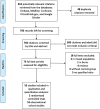Does the evidence support the importance of high transfusion ratios of plasma and platelets to red blood cells in improving outcomes in severely injured patients: a systematic review and meta-analyses
- PMID: 31614006
- PMCID: PMC6900194
- DOI: 10.1111/trf.15540
Does the evidence support the importance of high transfusion ratios of plasma and platelets to red blood cells in improving outcomes in severely injured patients: a systematic review and meta-analyses
Abstract
Background: Deaths by exsanguination in trauma are preventable with hemorrhage control and resuscitation with allogeneic blood products (ABPs). The ideal transfusion ratio is unknown. We compared efficacy and safety of high transfusion ratios of FFP:RBC and PLT:RBC with low ratios in trauma.
Study design and methods: Medline, Embase, Cochrane, and Controlled Clinical Trials Register were searched. Observational and randomized data were included. Risk of bias was assessed using validated tools. Primary outcome was 24-h and 30-day mortality. Secondary outcomes were exposure to ABPs and improvement of coagulopathy. Meta-analysis was conducted using a random-effects model. Strength and evidence quality were graded using GRADE profile RESULTS: 55 studies were included (2 randomized and 53 observational), with low and moderate risk of bias, respectively, and overall low evidence quality. The two RCTs showed no mortality difference (odds ratio [OR], 1.35; 95% confidence interval [CI], 0.40-4.59). Observational studies reported lower mortality in high FFP:RBCs ratio (OR, 0.38 [95% CI, 0.22-0.68] for 1:1 vs. <1:1; OR, 0.42 [95% CI, 0.22-0.81] for 1:1.5 vs. <1:1.5; and OR, 0.47 [95% CI, 0.31-0.71] for 1:2 vs. <1:2, respectively). Meta-analyses in observational studies showed no difference in exposure to ABPs. No data on coagulopathy for meta-analysis was identified.
Conclusions: Meta-analyses in observational studies suggest survival benefit and no difference in exposure to ABPs. No survival benefit in RCTs was identified. These conflicting results should be interpreted with caution. Studies are mostly observational, with relatively small sample sizes, nonrandom treatment allocation, and high potential for confounding. Further research is warranted.
© 2019 The Authors. Transfusion published by Wiley Periodicals, Inc. on behalf of AABB.
Conflict of interest statement
The authors have disclosed no conflicts of interest.
Figures




References
-
- US Centers for Disease Control and Prevention. Injury prevention and control: data and statistics (WISQARS), 2014. Accessed September 2019.
-
- Hess JR, Brohi K, Dutton RP, et al. The coagulopathy of trauma: a review of mechanisms. J Trauma 2008;65:748‐54. - PubMed
-
- Stahel P, Moore E, Schreier L, et al. Transfusion strategies in postinjury coagulopathy. Curr Opin Anaesthesiol 2009;22:289‐98. - PubMed
Publication types
MeSH terms
LinkOut - more resources
Full Text Sources
Medical

